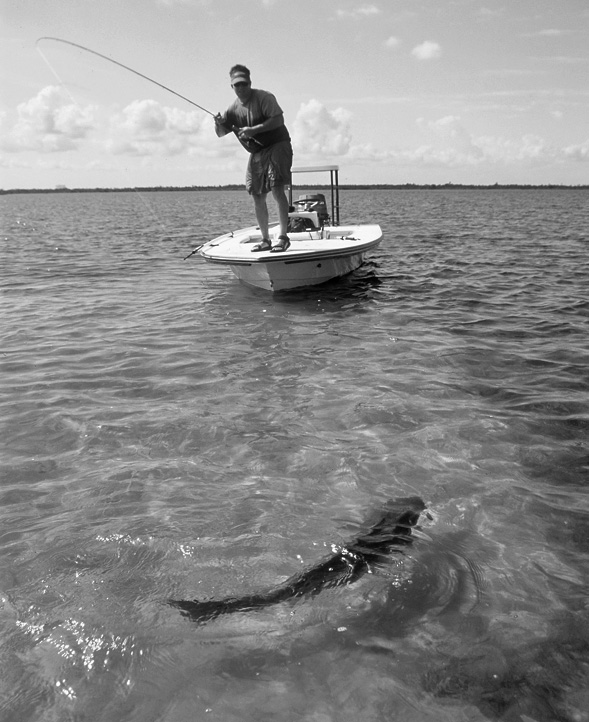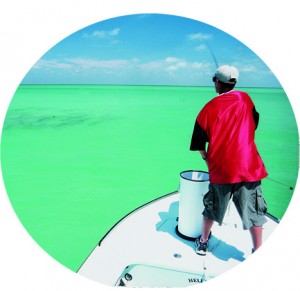November 09, 2015
By John Kumiski
Tips for more successful saltwater fly fishing.

The old saw, “Ten percent of fishermen catch 90 percent of the fish” might go double for saltwater fly fishers, given the technical nature of fly fishing. Even more so for sight fishing the flats. Fly fishers who catch flats fish consistently, either in prestigious tournaments or otherwise, formulize their game plan and prepare their gear the night before, or days before, a fishing trip. Then it's all systems go out on the water. Plus, they hunt, cast and fish their flies in a way that gets the bite. Let's look at some tips that'll put you in that 10 percent class.
Keep Stuff Handy
Whenever possible, rig your fly rods with the correct leaders and flies for the anticipated fishing at the outset of your fishing day. Don't stash a bunch of rods in the boat, motor up to a flat at first light and fuss with rigging--that's time wasted and opportunities blown. It goes beyond stringing up your rod and tying on a fly at home. It's an ideal opportunity to clean and/or dress your fly line, check your backing and line-to-leader knots, too. Leader material is cheap. When in doubt, toss it out! A new leader is always the best leader.
Tools at Hand
Have your tools within reach while on the water. There's nothing worse than digging around in the boat for flies, new leader, or a spare spool or reel. Decide which flies you'll want to fish throughout the day, and keep them in reach, whether that's in your pocket or your fly box. Sharpen them ahead of time, too. Have you ever had a refusal from a fish, and then took a “time out” to hunt for a fly? Many anglers can tell stories about casting to a school of reds, getting snubbed, quickly switching flies, casting again and hooking up. It happens all the time. Also, a leader or two ready to loop on your line will save time and opportunities. At least store a small spool of tippet in your shirt or pants pocket. Should you decide to lengthen your leader when the fish prove spooky, or you discover a nick or abrasion, you are back in the game quickly. A spare spool or reel with either an intermediate or sinking line may come in handy when fishing deeper edges for tarpon, snook, or even redfish or bonefish in some situations. Always carry them in your boat, or tackle bag if fishing in a friend's or a guide's boat.
Maximize the Hunt
In other words, cover ground quickly to find fish. Too many fly fishers milk a flat that “always delivers.” When poling or searching via electric motor, don't get caught in a time warp. It's easy to get caught up in it, and in time, you'll see fish that are not there. Don't stare; let your eyes scan and catch movement. Then zero in to make an ID, or better yet, make a cast to any suspicious form. It may be the fish you are looking for. In general, spend more time on a flat that has other life—rays, sharks, baitfish—and don't waste much time in a “desert.”
Slow Down
Fish slowly where you find life on a flat. Sometimes, particularly where the current is ripping, it's even a good idea to stop poling, stake out or engage the Power-Pole, to let fish come into range. Keep your eyes “down-sun” whenever possible, unless tailing fish are plentiful, which can be spotted when looking into the sun's glare.

Stay in the Zone
Know your comfort zone. Just try to cast from the maximum distance you can handle. If that's from 70 feet or more away, you'll catch more fish on the flats. But in reality, most sight-fishing fly casts are shorter, because fish can pop up at any time. Also, the light may be bad, or the water muddy. It's often more effective to make an accurate short cast than to attempt a long bomb that does not turn your leader and fly over. Whenever possible, pole closer before casting, but don't crowd ‘em!
Silence is Golden
And this rule goes beyond poling quietly, not banging the pushpole against the gunnel or bottom. Tread lightly--if wearing shoes, do not move your feet unnecessarily. Fish can hear your soles striking the deck. Better yet, wear just socks or go barefoot. It's quieter, and as a plus, you can feel your fly line should it get underfoot. And that can spool your cast, big time. Keep your feet close together. That will discourage the chance that you will “rock the boat” by shifting weight from one foot to the other when casting. That sends out pressure wakes that fish detect.
Where the bottom supports you, wade to closer to a fish to present your fly. When bonefishing for trophy fish, you may have to wade to a spooky tailer. If you find a funnel where schools of bones are filing through, consider getting out and letting them come to you.
Keep it Real
Make the fly look real. As is the case with all artificial lures, you should never strip your fly toward a flats fish. On rare occasion, that may trigger a reaction strike; usually it results in a spooked fish. A predator is not accustomed to being attacked by its food. If at all possible, present the fly so that you can strip it straight away, or at least at a right angle, away from the fish. On hard-fished flats, this is especially essential. And don't “overfish” it. Don't strip so that the fish has to work to catch it. Let the fish see the thing. With stationary snook or laid-up tarpon, all it takes is a little quiver to make a fly breathe and that is sometimes all it takes. When fishing bones or redfish, once the fish tracks, the best strip is none at all. Let the fly sink to the bottom to imitate a crab or shrimp heading for cover. FS
First Published Florida Sportsman September 2009
